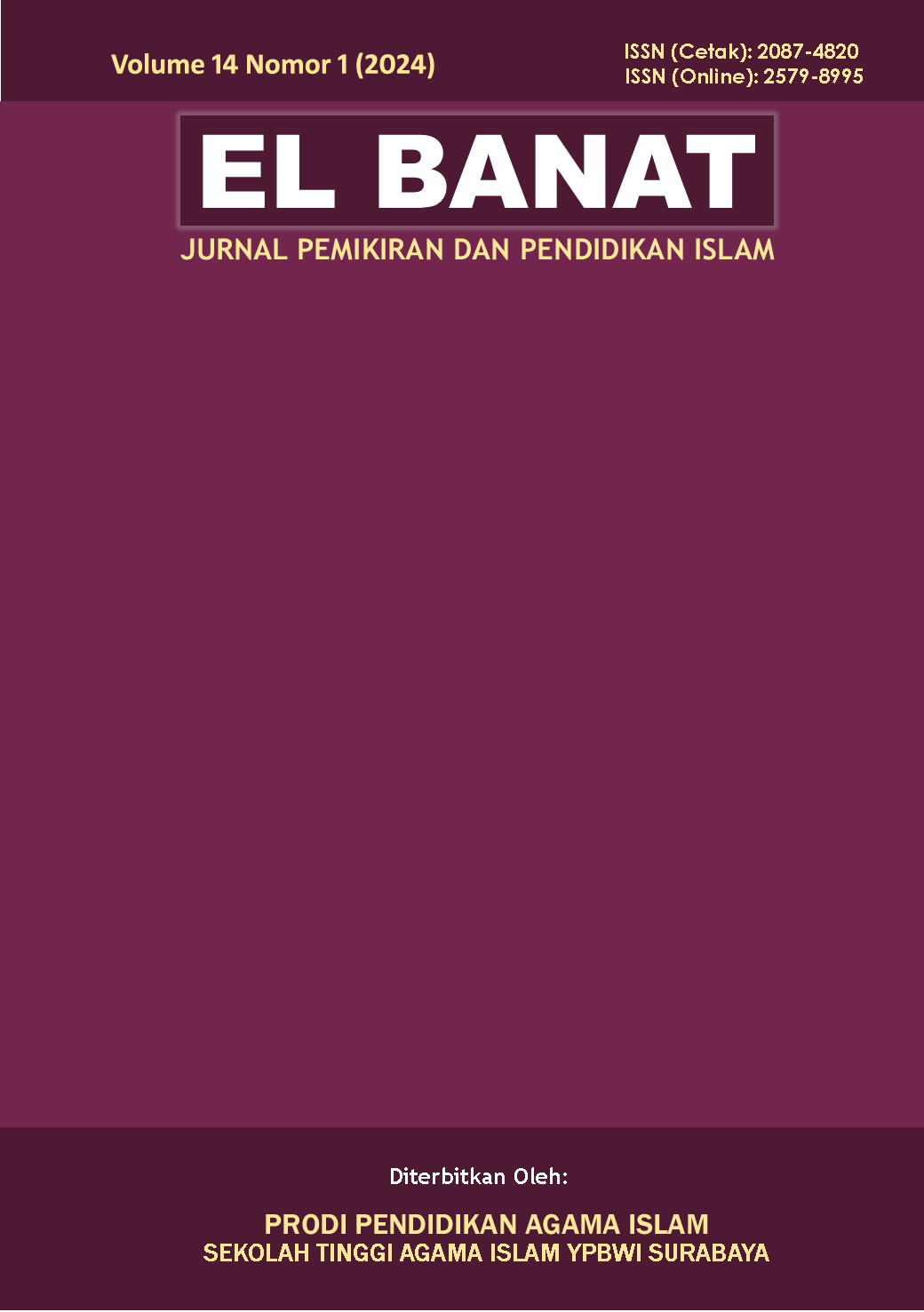Analisis Kemampuan Literasi Numerasi Siswa Melalui Soal Model PISA Berbasis Konteks Keislaman di Sekolah Dasar Muhammadiyah 15 Surakarta
DOI:
https://doi.org/10.54180/elbanat.2025.15.1.196-211Keywords:
Numeracy Literacy Skills, PISA Model QuestionsAbstract
The low ability of students to understand questions in the Programme for International Student Assessment (PISA) model, as reflected in the results of the previous Minimum Competency Assessment (AKM), has become a serious concern in Indonesian education. Many students struggle to solve literacy and numeracy questions based on real-life contexts that require higher-order thinking skills. This indicates a gap between classroom learning processes and the demands of competency assessments that emphasize analytical, reflective, and applied skills. This study employs a qualitative descriptive method. The instruments used in this research include tests, interviews, and observations. The results of the study show that 50% of students had difficulty answering questions in diagram form, while 83.3% had difficulty with comparison-based questions. Low-level questions could be solved with an 80% success rate, but the success rate dropped to 55% for medium-level questions and only 10% for high-level questions requiring critical thinking and mathematical modeling skills. Common errors made by students include misunderstanding the question (40%), simple calculation errors (30%), and difficulty in constructing mathematical models (10%). These findings indicate the need for problem-based learning and the use of context to enhance students' critical and creative thinking skills. Additionally.
Downloads
References
Charmila, D., Mahmudah, A., & Ilyas, M. (2022). Pengaruh Latihan Soal Model PISA terhadap Kemampuan Literasi Matematika Siswa. Jurnal Pendidikan Matematika, 8(1), 15-23.
Creswell, J. W. (2020). Educational Research: Planning, Conducting, and Evaluating Quantitative and Qualitative Research. Boston: Pearson.
Creswell, J. W. (2021). Qualitative Inquiry and Research Design: Choosing Among Five Approaches. Sage Publications.
Han, W., Susanto, D., Dewayani, S., & Pandora, P. (2017). Materi Pendukung Literasi Numerasi. Kementerian Pendidikan dan Kebudayaan Jakarta.
Hapsari, T. A. R. (2023). Penerapan Literasi Numerasi pada Pelajaran Pendidikan Agama Islam (PAI) di Madrasah. Journal of Progressive of Cognitive and Ability, 2(4) 499 - 504. doi: 10.56855/jpr.v1i4.753
Hariyati, A., & Purwanto, R. (2023). Implementing the Contextual Approach in Mathematics Learning to Enhance Students’ Problem-Solving Abilities. ASIAN: Indonesian Journal of Learning Development and Innovation, 1(1), 7–12.
Hutapea, N. M., Saragih, S., & Sakur, S. (2019). Improving Mathematical Communication Skills of SMP Students Through Contextual Learning. Journal of Physics: Conference Series, 1351(1). https://doi.org/10.1088/1742-6596/1351/1/012067
Ijtahidah, F. F., & Nisa’, R. (2023). Pengembangan soal literasi numerasi SMP yang terintegrasi Islam. Primatika: Jurnal Pendidikan Matematika, 12(1), 1–8. https://doi.org/10.30872/primatika.v12i1.159
Junika, N., Izzati, N., & Tambunan, L. R. (2020). Pengembangan soal statistika model PISA untuk melatih kemampuan literasi statistika siswa. Mosharafa: Jurnal Pendidikan Matematika, 9(3), 499-510.
Latifah, T., & Afriansyah, E., A. (2021). Kemampuan Pemecahan Masalah Matematis Siswa pada Materi Statistika. Journal of Authentic Research on Mathematics Education (JARME), 3(2), 134-150. https://doi.org/10.37058/jarme.v3i2.3207
Lestari, D. I., & Kurnia, H. (2023). Implementasi model pembelajaran inovatif untuk meningkatkan kompetensi profesional guru di era digital. JPG: Jurnal Pendidikan Guru, 4(3), 205-222.
Mahmud, Amir, and Mukhammad Wahyudi. “Metode Edukatif Gaming Pada Model Pembelajaran Blended Learning Untuk Meningkatkan Hasil Belajar Siswa.” WALADI 2, no. 1 (2024): 1–25.
Munadi, R., & Rahayu, P. (2022). Peningkatan Literasi Dan Numerasi Peserta Didik Uptd Spf Sdn 29 Cenrana Melalui Program Kampus Mengajar. Jurnal Abdimas Indonesia, 2(2), 303–309. https://doi.org/10.53769/jai.v2i2.285
Muhamad, N., & Agustina, L. (2023). Penerapan Model Project Based Learning (PJBL) Untuk Meningkatkan Kemampuan Berpikir Kreatif Pada Pembelajaran Matematika. Jurnal PGSD UNIGA, 2(2).
Purnamasari, N. I., & Rohmawati, H. (2023). Implementasi Kegiatan Bermain Huruf dalam Melatih Kemampuan Literasi Membaca Dasar Anak Usia Dini. EL-BANAT: Jurnal Pemikiran Dan Pendidikan Islam, 13(1), 117-141. https://doi.org/10.54180/elbanat.2023.13.1.117-141
Putri, N. N., Alvira, S., Nurjanah, I. J., Umairoh, U., & Rostika, D. (2023). Analisis Kesulitan Belajar Matematika Siswa Sekolah Dasar pada Materi Perbandingan dan Skala. Didaktik: Jurnal Ilmiah PGSD STKIP Subang, 9(5), 3579 - 3590. https://doi.org/10.36989/didaktik.v9i5.2459
OECD. (2022). PISA 2018 Results: What Students Know and Can Do. Paris: Organisation for Economic Co-operation and Development.
OECD. (2022). PISA 2022 Results: Insights and Implications for Policy and Practice. Paris: Organisation for Economic Co-operation and Development.
Priantari, I., Suratno, S., Wahyuni, D., & Dafik, D. (2023). Stem education and research-based learning activities on taste roasted in coffee., 500-511. https://doi.org/10.2991/978-94-6463-166-1_60
Salafudin. (2015). Pembelajaran Matematika Yang Bermuatan Nilai Islam. Jurnal Penelitian, 12(2), 223–243. https://doi.org/10.28918/jupe.v12i2.651
Setiawati, R., Aminudin, M., & Basir, M. A. (2023). Analisis Literasi Numerasi Peserta Didik dalam Menyelesaikan Masalah Uncertainty and Data. Jurnal Pendidikan Sultan Agung, 3(2), 123. https://doi.org/10.30659/jp-sa.3.2.123-133
Shafie, H. (2023). Education qualifications and teaching experience on the 21st century tpack level of english language teachers., 4-15. https://doi.org/10.2991/978-2-38476-120-3_2
Shopia, K., Sudarmaji, I., Purnawati, P., Chairunnisa, D., & Febriliyana, N. (2022). Analysis of english teachers’ professional competence in 21st century learning. https://doi.org/10.4108/eai.25-11-2021.2318834
Silva, D., Sobrinho, M., & Valentim, N. (2019). Steam and digital storytelling: a case study with high school students in the context of education 4.0., 159. https://doi.org/10.5753/cbie.sbie.2019.159
Siregar, N., & Sulistyo, E. (2021). Latihan Soal PISA untuk Meningkatkan Kemampuan Pemecahan Masalah Matematika. Jurnal Pendidikan dan Kebudayaan, 3(4), 45-50.
Sujarwo, Safitri, D., Marini, A., & Ibrahim, N. (2022). Pelatihan Pengembangan Assessment Berbasis Literasi Numerasi Bagi Guru Sekolah Dasar Cisaat Subang Jawa Barat. Jurnal Pengabdian Kepada Masyarakat, 2, 4329–4336.
Ulinnuha, M. and Indartono, S. (2019). Teacher readiness level facing technology demands, pedagogical skills and development of school culture in the 21st century.. https://doi.org/10.2991/iconprocs-19.2019.15
Ummah, S. C. (2019). Paradigma keilmuan Islam di perguruan tinggi. Humanika, Kajian Ilmiah Mata Kuliah Umum, 19(2), 100-120. http://dx.doi.org/10.21831/hum.v19i2.30300
Yuliana, T., & Satria, F. (2021). Pentingnya Literasi Matematika dalam Kehidupan Sehari-hari. Jurnal Matematika dan Pendidikan Matematika, 12(3), 221-230.
Yulianto, T., Pramudya, I., & Slamet, I. (2020). How the effects of the 21st-century learning model on higher level thinking ability and mathematical learning creativity viewed from student mathematical disposition. https://doi.org/10.2991/assehr.k.200129.132





